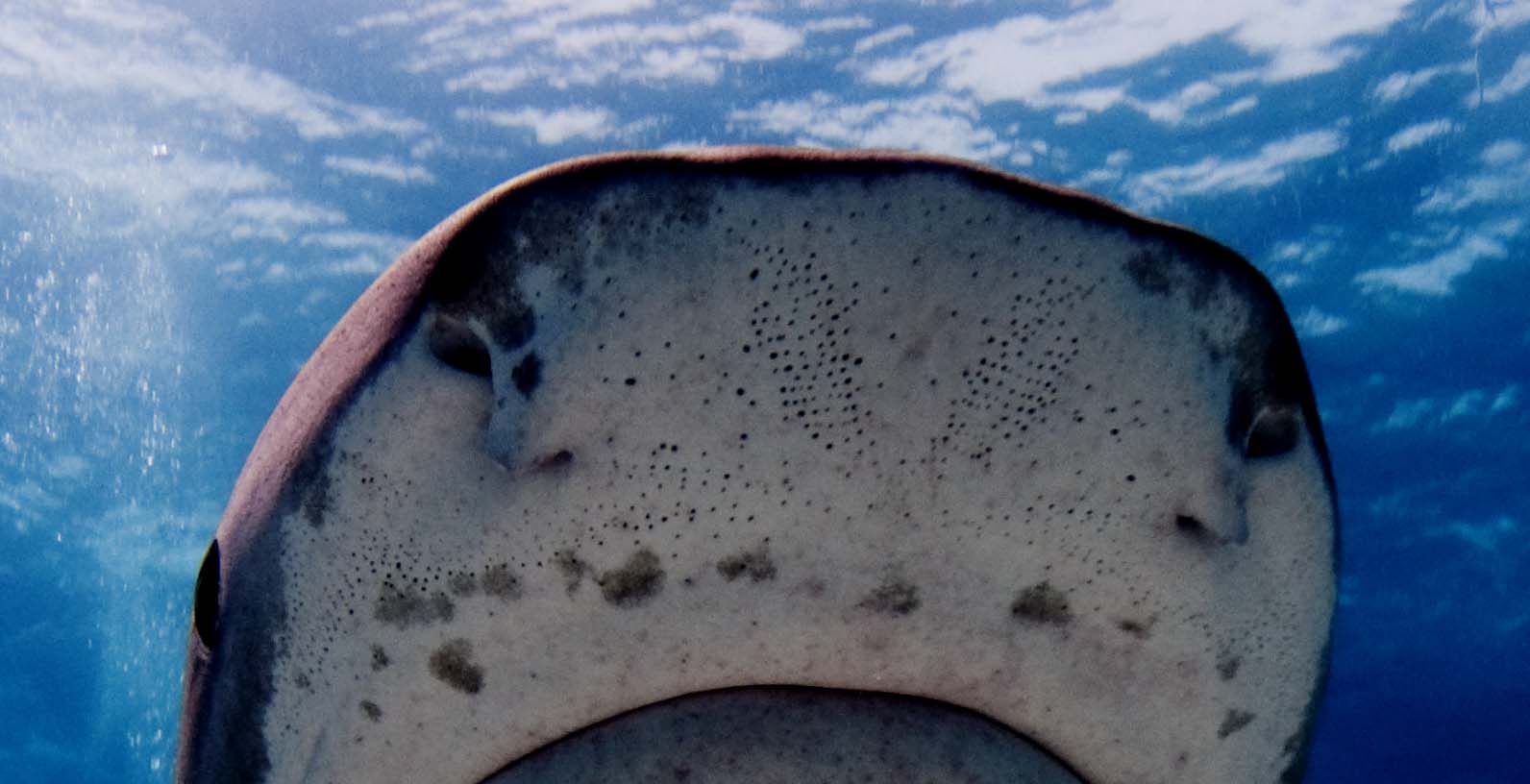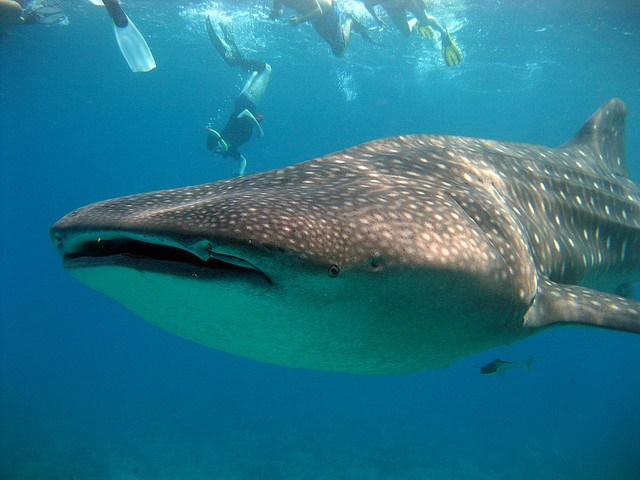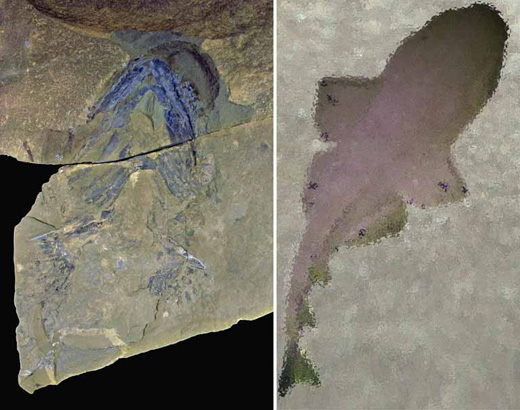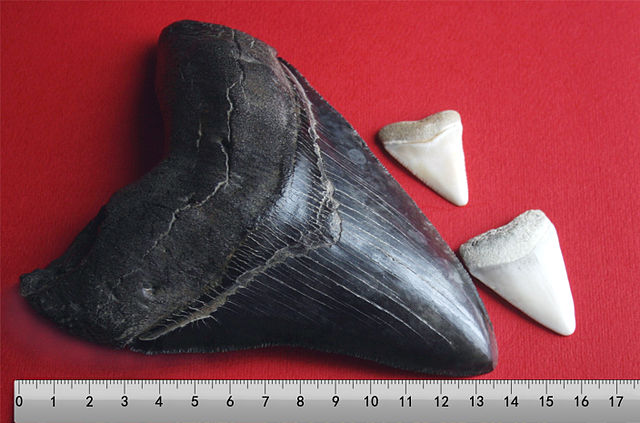Sharks
Article curated by Rowena Fletcher-Wood
Sharks are cartilaginous fish related to rays - and one of our most poorly understood animals. They are also extremely difficult to study: not only are oceans tricky for us to access, but sharks cross vast distances along the ocean floor, sometimes kilometers per day at paces up to 45 km/hour. As top predators, sharks are dangerous to track and interact with. Not that this deters us - if anything, it enhances our curiosity.
We are not afraid of predators, we’re transfixed by them, prone to weave stories and fables and chatter endlessly about them, because fascination creates preparedness, and preparedness, survival. In a deeply tribal way, we love our monsters…” E.O. Wilson, sociobiologist

Shark physiology
With a history extending back at least 300 million years, the shark is older than the dinosaur. In all those years, they have had plenty of time to prime their senses to make themselves the apex predators they are today.
Although the shark, like us, can use touch to gain tactile information, they also have another way: the lateral line. Unique to aquatic vertebrates, the lateral line is a canal running just below the skin containing fluid and tiny epithelial hairs. It connects to the seawater outside of the shark’s body via a line of tiny pores and registers turbulence and pressure changes to provide three-dimensional hydrodynamic sensory impressions. Sharks use the lateral line to detect prey, mates and to navigate in the ocean.
In a process known as eddy chemotaxis, the perception of smell and turbulence are often combined to the extent that suppressing the lateral line with antibiotics makes a shark appear “nose-blind”.
Even more powerful and strange are the ampullae of Lorenzini. These small black pores that pepper the heads of sharks are extremely sensitive electroreceptors. They operate like small, living batteries to detect field differences in the iron-rich seawater. Sharks are currently considered the most sensitive species to electric fields, possibly detecting electrical signals as low as 5 nV/cm, or five billionths of a volt 1 cm away. Sharks can detect muscle contractions from prey buried out of sight in the sand, and will attack electric dipoles concealed in bundles, selecting electrode-containing bundles over empty ones[1]. Researchers are still speculating whether the ampullae can detect temperature gradients by transforming them into electrical signals [2].
Shark perceive sounds outside the range we detect, but their own range is narrower: sharks are low frequency detectors. This makes them optimised to pick up the kinds of noises produced by water turbulence: swimming, thrashing and splashing.
Although small, a huge amount of shark brain space is allocated to vision, suggesting that the shark is a highly visual predator. However, some researchers believe that sharks are colour blind. This hypothesis follows years of speculation and observation of behaviour, and sequencing photoreceptor proteins in rods and cones of wobbegong sharks, which revealed they only had one kind of cone. This is strong evidence that wobbegongs are colour blind, but doesn’t confirm colour blindness in other sharks species. New research into cephalopods suggest that there may be other mechanisms for seeing colour.
Learn more about /shark physiology.


Let sleeping sharks lie
Sleeping is a normal part of being human, but sharks don’t sleep - at least, not the way we recognise sleep. Some sharks don’t seem to sleep at all, and those that do are never fully unconscious: they keep their eyes open and other senses “switched on” to pick up events happening around them.
Those sharks that can pump water across their gills to get oxygen can lie still and sleep more deeply; but some sharks don’t pump water and have to move to get enough oxygen flow to breathe. This means that sharks literally can’t keep still: if they stop moving, they suffocate and die. These sharks have to sleep only half of their brain at any one time, the other half fully alert. They can voluntarily switch back and forth. How they do this or how it feels lies beyond our current understanding and reflects one of the more unearthly aspects of these apex predators. What we do know is that the way sleep works in sharks is vastly different from sleep in humans; in the dogfish, for example its spine rather than brain stimulates it to swim, so the shark can sleep whilst still being able to get oxygen to breathe.


 2
2
The social shark
Behavioural understanding of shark species is “alarmingly incomplete”[3], and most studies have taken place in captivity. In the wild, sharks have been observed doing many of the things that we consider evidence for social instincts, such as congregating in packs (sometimes reaching over 100 animals), and actively cooperating in teams. In one 1987 study, wild sharks in Smitswinkel Bay, South Africa, were observed working together to manoeuvre a whale corpse into deep water where they could all feed upon it. They have also been seen engaging in play: mackerel sharks have been seen using their snouts to push about flotsam, and porbeagle sharks caught deliberately rolling in seaweed to engtangle themselves, before chasing after their tails of kelp.
This suggests that sharks can communicate, yet some scientists still speculate about it because we have never observed emitted sound signals. Sharks might listen, but they don’t ‘talk’. If they do communicate directly, they must do it through another means, such as body movement. Over fifty distinct movement patterns have been isolated in shark behaviour. They are also very tactile investigators and will bump noises with foreign objects when they wish to identify them. A further possibility is pheromones. Although we are not sure whether sharks use pheromones, they are a well-known way of communicating recognised throughout the animal kingdom. It is even possible sharks may communicate on a cellular level using their electroreceptors to sense the salt solution in each other’s cells. How they could end out signals intentionally like this is unclear though. The secret nature of how sharks “talk” is yet to be uncovered.
Learn more about /the social shark.


 3
3Shark hunting and conservation
In the wild, shark nose butting and circling is often interpreted as an intention to attack, but shark attacks are uncommon. You have a better chance of winning the lottery than being attacked by a shark.
More humans even eat sharks than sharks eat humans. Around 100 million are destroyed by humans every year, equivalent to 11,000 an hour[4][5].
Major culprits are the Chinese shark fin soup trade and long-standing pseudoscientific belief that sharks don’t get cancer, leading to shark “pills”. Sharks do get cancer. We don’t know if there is a way animals can be immune to cancer, but we do know shark cancer exists, but is different to ours because they are cartilage based[6]. When it comes to rates of the disease, however, we just don't know - sick sharks are rarely around long enough to captured and studied.


 2
2No one is quite sure why sharks attack humans. One interpretation is sharks mistaking humans for seals. However, scientists argue that sharks have too well developed sight, smell and electric signals to make this mistake. But the theory is consistent with “surprise” that explains why sharks will bite a human once only and then back off. On the other hand, they could be waiting for us to die of blood loss without exhausting themselves. Interestingly, if two or more possible prey victims are present, sharks only attack one. This is thought to result from sensory overload from the blood-oozing, splashing victim.
Whilst the tiger shark is an indiscriminate predator that will literally eat anything, most sharks are picky. The two largest sharks, the whale shark and the basking shark, are filter feeders, not hunters. Larger and older sharks select for blubbery marine mammals like seals, and smaller, younger sharks select for fish. This choice depends on tooth shape, and whether a shark is a number maximiser, eating whatever comes their way, or energy maximisers, prioritising high energy prey and conserving as much energy as possible hunting. Many sharks, especially small ones, are pack hunters.
Sharks can go for a long time without eating, and can store nutrients like a camel and regrow their teeth throughout their lives. A single shark may grow 300 rows of 100 teeth during its lifetime.
Shark culling could have dire consequences for ocean ecology, and does not act as a deterrent. We know that apex predators make a huge impact on the environment in which they inhabit and contribute to biodiversity. This is known as a trophic cascade.
Effective shark deterrents are still being explored in conjunction with sensible precautions such as not wearing shiny jewellery in the water, splashing excessively or diving during shark peak feeding times, such as dusk. Shark shields - portable electric field devices - are good short-range shark deterrents. However, prolonged testing showed that sharks eventually get used to them. Scientists have proposed a changing electric field as a permanent repellent, and barrier repellents, like the bubble curtain, a wall of bubbles oozing from pipes laid on the ocean floor. We don’t yet know whether sharks might get used to this over time. Visual technology includes wetsuit design to camouflage swimmers against the ocean, or disguise them as the poisonous black and white striped sea snake.
One elusive goal of shark repellent research is an environmentally safe chemical repellent. Researchers have identified natural and man-made substances that produce effects in sharks, but many of these chemicals act only over a very short range. One naturally occurring long-range substance does exist: the shark necromone, a complex soup of amino acids and putrefaction products that comes from a decomposing, dead shark. Gas chromatography has been used to isolate some of these chemicals, but more research is needed to find the active ingredient that alerts sharks to the death of one of their own.
Learn more about /shark hunting and conservation.


 2
2
Shark tagging is employed not only to forewarn people of shark entrances into populated beach areas, but also to map them on their travels and understand their natural routines. There is still so much we don’t know about shark migration and movement.
Some sharks, such as hammerheads, have daily routines, whilst many, such as the lemon shark are crepuscular. The range of observed activity in sharks suggests a divergence in circadian rhythm, and could be used to identify the evolutionary history of these species. However, some sharks still appear to behave irregularly to us, and we don’t know what is influencing these species.
Seasonal migrations are common, and it is also possible that sharks also undertake gradual climate-driven migrations. Most sharks are poikilothermic, their internal body temperature identical to that of their external environment, and need to live at the temperatures when their bodies function best. Sharks may also be sensitive to ocean acidification, driven by the absorbance of additional CO2 present in the atmosphere, either directly by changes in pH, or indirectly, following migrating tropical fish, or exploring more widely as food sources become scarce. This could explain apparent increases in shark populations along the West Australian coast.
Learn more about /shark migration and movement.


The captive shark
We still don’t know how to engineer truly suitable shark tanks for the great white, used to travelling hundreds of kilometres daily. Large sharks also have large appetites, and great whites can be fussy, preferring live prey and killing everything in their tank, changing the ecology and requiring regular cleaning. Tanks are hard to maintain at the correct temperature and salinity.
Only juveniles have been kept successfully. Monterey Bay Aquarium in California holds the world’s record for a great white survival in captivity: 198 days. However, after growing more than 14 inches, the young female shark became unmanageably big, was released, and died, possibly due to stress.
It is thought that being contained in a small area is stressful because great whites need to move to breathe: enclosed, they panic. Frequently, great white sharks are observed nose butting the sides of their enclosures – this could just be the result of curiosity, or distress. Capture and transport is therefore incredibly expensive, dangerous and difficult.
Since tonic immobility causes no apparent distress, it is widely used by shark scientists to capture and handle dangerous species. Tonic immobility is an unlearned reflex where a specific kind of stimulation induces a state of temporary paralysis, muscles relax and respiration becomes slow and deep, like in sleep or a deep coma. Sharks may be placed into tonic immobility by stroking or placing hands on the snout (tiger sharks) or turning them upside down (great whites). The effectiveness of a given mechanism depends on the species and the response will be idiosyncratic of the individual. Scientists think that these states induce tonic immobility by providing the shark with a sensory overload via its delicate electroreceptors.
Normally a response to predator threats, nobody’s quite sure why predatory sharks should have evolved this as a defence mechanism. Theories suggest it may be connected to mating.
Female sharks can respond to captivity in a unique way: reproducing by parthenogenesis – asexually. This was first observed in 2001 at the Henry Doorly Zoo in Omaha in a female bonnethead shark that, kept with other females, gave birth to a female pup with no male DNA[7]. Parthenogenesis is known to occur extremely rarely in other vertebrates such as snakes and lizards as a last-resort mechanism, but only captivity conditions have allows it to recently be identified in sharks[8].
Another evolutionary tactic is that of multiple-paternity, where a female can have one litter with multiple fathers. However, this is also something scientists know little about. In the first genetic assessment of tiger sharks, scientists were surprised to observe no or little multiple-paternity amongst the heavily-hunted species, and felt it could impact their conservation.
Learn more about /the captive shark.



Shark evolution
If parthenogenesis is one form of shark evolution that we have only recently recognised, there remains an ocean of unknowns in the shark history. The fossil evidence of sea creatures is naturally sparser than that of land mammals, simply because the places they are found are often more inaccessible. In addition, sharks are boneless, and cartilaginous fish fossils are much rarer finds than those of their boney companions as cartilage usually corrodes away, leaving no trace. This makes sharks particularly elusive. These ocean monsters, and so their fossils, even date back to before the dinosaurs; sharks are believed to have arisen around 455 million years ago, and early sharks still remain recognisable as ancestors to the sharks of today, sharing common features such as dorsal fin spines. The oldest known shark fossil, Doliodus Problematicus, is 409 million years old.
Despite all this, we do know a little about shark evolution. 2500 or so fossils of different species have been uncovered, mostly only from parts such as vertebrae, teeth and fin spines. Shark numbers and varieties were highest during the carboniferous period, 360-300 million years ago, before many became extinct, possibly due to changes in food availability or habitat. Later, the species that survived diversified, and new kinds of sharks appeared.
One very interesting carboniferous shark was edestus, the scissor-toothed shark, closely related to chimaeras. This shark sported characteristic protruding teeth that formed when new teeth grew behind the old row, forcing them outwards. Shark scientists are not entirely sure how this jaw morphology was a good idea for hunting, but they can be sure from the tooth shape that edestus was carnivorous.
One more recent (merely 270 million year old) shark, helicoprion or spiral saw shark, went even further: its jaw was whorl-shaped, although for many years scientists debated where the spiral of teeth went that makes helicoprion the weirdest looking shark in history. Some believed the whorl was a defensive display on its back or tail, whilst others thought it functioned directly in feeding. This mystery was not elucidated until cranial cartilage was found attached to the whorl in one lucky fossil find by Svend Erik Bendix-Almgreen in 1950. This confirmed that the whorl was some part of the jaw. Recent x-rays scans of ancient fossils have now created a 3D image of the shark’s head, showing the whorl fused to the lower jaw and inside it, where it must have functioned as a tooth factory and possibly a slicer for a diet of soft-bodied prey[9][10].
Filter-feeder sharks are believed to have evolved more recently, 65-35 million years ago. However, hammerheads are the most recently evolved family of sharks around today. Only 50-35 million years old, they are the infants of evolution. Most famous of all ancient sharks is the megalodon, the legendary giant shark of the ocean, which dates back only 30 million years. This shark might have been as long as 18 m: that is the same as two buses or three great whites. These giant monsters were the apex of apex predators, living at the same time and in the same places as great white sharks, most probably also feeding on them. However, their time was fleeting and they became extinct 3 million years ago. This has not stopped them from capturing public imagination, or sightings from being reported, and even scientists are curious about the sheer force and magnitude of these beasts.



New species of cow sharks have been discovered as recently as 2018. These are unique in being a family with more than 5 gills (all other shark species but one have 5 gills), and most cow sharks have 6 or 7 gills. They are also the closest living sharks today to prehistoric sharks. Because they live in deep waters, we know little about these and are still learning more. The oldest fossils that have been found are from the Jurassic period, but there is one tooth found upper permian deposits in Japan that looks like it is cow shark and hints at a much older origin – we’re not sure.


Researchers examining bite force have been astonished by the ability of great whites to bite through bone despite its elastic cartilaginous jaws, which should in theory be too flimsy. However, best estimates at mechanism and power imply a crushing force of 1.8 tonnes: the biggest bite force on earth[11]. Scaled up to a megalodon, even conservative estimates reckon the bite force must be at least 10 times higher. So chew on that one!



Whilst this article attempts to explore some of the great mysteries of sharks, it is by no means exhaustive. The unknowns about sharks are many and diverse. Their feeding, breeding and activity habits are strange and seem unpredictable, whilst our history of interaction with them is short compared with our adaption to the ecosystem found on land. Scientists can only attempt to keep up.
This article was written by the Things We Don’t Know editorial team, with contributions from Rowena Fletcher-Wood.
This article was first published on 2016-02-13 and was last updated on 2021-07-29.
References
why don’t all references have links?
[1] Kalmijn, A. J. 1971. The Electric Sense of Sharks and Rays. Journal of Experimental Biology, 55, 371-383
[2] Brown BR (2010) 'Temperature response in electrosensors and thermal voltages in electrolytes'. J Biol Phys 36 (2): 121–134. doi:10.1007/s10867-009-9174-8
[3] Bres, M., (1993) The behaviour of sharks Reviews in Fish Biology and Fisheries 3(2):133-159. DOI: 10.1007/BF00045229
[4] Clarke, S,C., et al., (2006) Global estimates of shark catches using trade records from commercial markets Ecology Letters 9(10):1115-1126 DOI: 10.1111/j.1461-0248.2006.00968.x
[5] Worm, B., et al., (2013) Global catches, exploitation rates, and rebuilding options for sharks Marine Policy 40:194-204 DOI: 10.1016/j.marpol.2012.12.034
[6] Finkelstein, J,B., (2005) Sharks Do Get Cancer: Few Surprises in Cartilage Research JNCI Journal of the National Cancer Institute 97(21):1562-1563 DOI: 10.1093/jnci/dji392
[7] Chapman, D,D., et al., (2007) Virgin birth in a hammerhead shark Biology Letters 3(4):425-427 DOI: 10.1098/rsbl.2007.0189
[8] Fountain, H. (2007) Female Shark Reproduced Without Male DNA, Scientists Say New York Times May 23, 2007
[9] Crew, B. (2013) Prehistoric ghost shark Helicoprion's spiral-toothed jaw explained Scientific American February 27, 2013
[10] Tapanila, L., et al., (2013) Jaws for a spiral-tooth whorl: CT images reveal novel adaptation and phylogeny in fossil Helicoprion Biology Letters 9(2):20130057 DOI: 10.1098/rsbl.2013.0057
[11] Wroe, S., et al., (2008) Three-dimensional computer analysis of white shark jaw mechanics: how hard can a great white bite? Journal of Zoology 276(4):336-342 DOI: 10.1111/j.1469-7998.2008.00494.x
Blog posts about Sharks




Recent Sharks News
Get customised news updates on your homepage by subscribing to articles













